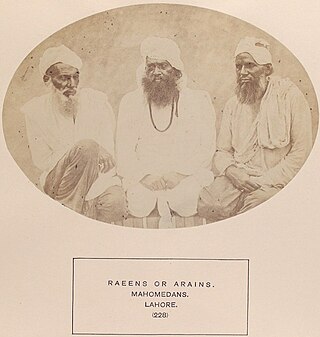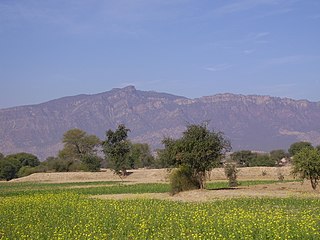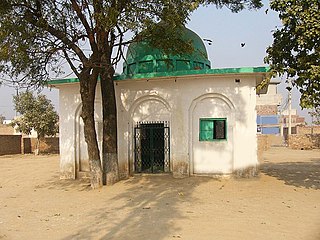
Punjab is a province of Pakistan. Located in central-eastern region of the country, Punjab is the second-largest province of Pakistan by land area and the largest by population. Lahore is the capital and the largest city of the province. Other major cities include Faisalabad, Rawalpindi, Gujranwala and Multan.
The Punjabis, are an Indo-Aryan ethnolinguistic group associated with the Punjab region, comprising areas of eastern Pakistan and northwestern India. They generally speak Standard Punjabi or various Punjabi dialects on both sides.

Sohawa is an administrative sub-division (Tehsil) of the Jhelum District, situated in the Punjab province of Pakistan, located in the northwestern part of the district. One sign of Sohawa is the toll plaza by the name of 'Tarakki' on the Grand Trunk Road. The main bazaar of Sohawa attracts people from nearby villages.

Arain are a large Punjabi agricultural tribe with a strong political identity and level of organisation, found mainly in the Pakistani provinces of Punjab and Sindh with a small population in parts of Indian Punjab, Uttar Pradesh and Uttarakhand.

Bahawalpur District is a district of Punjab, Pakistan, with capital the city of Bahawalpur. According to the 1998 Census it had a population of 2,433,091, of which 27.01% were urban. Bahawalpur district covers 24,830 km2. Approximately two-thirds of the district (16,000 km2) is covered by the Cholistan Desert, which extends into the Thar Desert of India. The district is a major producer of cotton.
Khokhar are a tribe native to the Pothohar Plateau of Pakistani Punjab. Khokhars are also found in Sindh and the Indian states of Punjab and Haryana. The word "Khokhar" itself is of Persian origin and means "bloodthirsty". Khokhars predominantly follow Islam while some continue to follow Hinduism in India. Many Khokhars converted to Islam from Hinduism after coming under the influence of Baba Farid.

Khanewal District is a district of the Punjab province of Pakistan. According to the 1998 census of Pakistan, the district had a population of 2,068,490, of which 17.42% were urban. Khanewal is located at 30°18'0N 71°55'0E with an altitude of 128 metres.
Hadda is a small village in the Punjab province of Pakistan. It is also famous by this name Hadda Ghughan Da(ہڈا گھگھاں دا). It is more than 300 years old and the native inhabitants speak the Jhang dialect of the Punjabi language. The area used to be savannah before allotment of lands in 1875 and construction of irrigation canals in 1905. The earliest bungalow built by the British in 1900 is also named after the village, although it is about 5 km (3.1 mi) to the south along the south branch of the canal.

Chiniot District, is a district in the Punjab province of Pakistan. It became the district in July 2009. Before this, it was a tehsil of Jhang District.
Punjab is home to 2.3% of India's population; with a density of 551 persons per km2. According to the provisional results of the 2011 national census, Punjab has a population of 27,743,338, making it the 16th most populated state in India. Of which male and female are 14,639,465 and 13,103,873 respectively. 32% of Punjab's population consists of Dalits. In the state, the rate of population growth is 13.9% (2011), lower than national average. Out of total population, 37.5% people live in urban regions. The total figure of population living in urban areas is 10,399,146 of which 5,545,989 are males and while remaining 4,853,157 are females. The urban population in the last 10 years has increased by 37.5%. According to the 2011 Census of India, Punjab, India has a population of around 27.7 million.

The Pothohar plateau, is a plateau situated in northern Punjab, Pakistan. It is bounded on the east by the Jhelum River, on the west by the Indus River, on the north by the Kala Chitta Range and the Margalla Hills, and on the south by the Salt Range.
Buddha Goraya / Budha Goraya / Budha Guraya is a town and Union Council in Nowshera Virkan Tehsil, Gujranwala District, Punjab, Pakistan.
Mochi are a community, found in North India, Pakistan and Bangladesh.They are the traditional shoemakers of South Asia.
Mehta Suja Railway Station is located in Mehta Suja village, Sheikhupura district of Punjab province of Pakistan.
Kakki Nau is a village 7 km southwest of Shorkot Tehsil, Jhang district, Punjab, Pakistan. It is named for a traditional tale that a dangerous lion was killed nearby.
Punjabi Muslims are adherents of Islam who identify ethnically, linguistically, culturally, and genealogically as Punjabis. With a population of more than 109 million, they are the largest ethnic group in Pakistan and the world's third-largest Islam-adhering ethnicity after Arabs and Bengalis. The majority of Punjabi Muslims are adherents of Sunni Islam, while a minority adhere to Shia Islam. They are primarily geographically native to the Punjab province of Pakistan, but many have ancestry from the Punjab region as a whole.

The Gondal Bar, named before the dominant caste in region, is a region between the rivers Chenab and Jhelum in Punjab, Pakistan. It is located in the northern part of Chaj Doab. "Bar", in the local language, means a forested area where there are no resources for cultivation, like water. Mandi Bahauddin District and some parts of Sargodha District and Gujrat District are known as Gondal Bar. It is a very fertile area. The Jats are the dominant people in the region. Gondal Bar is a vast area with a number of Punjabi tribes sharing same culture and the Punjabi as other bars.
Jasrat (Punjabi : جسرت , ਜਸਰਤ , romanised: Jasarata, lit. 'Valiance'; Punjabi pronunciation:, born Mustafa Jasrat Shaikha Khokhar was a Punjabi Khokhar chieftain who lead periodic raids and rebellion against the Delhi Sultanate in the early 15th century. He reigned in northern Punjab and Jammu between c.1420 and 1442.










